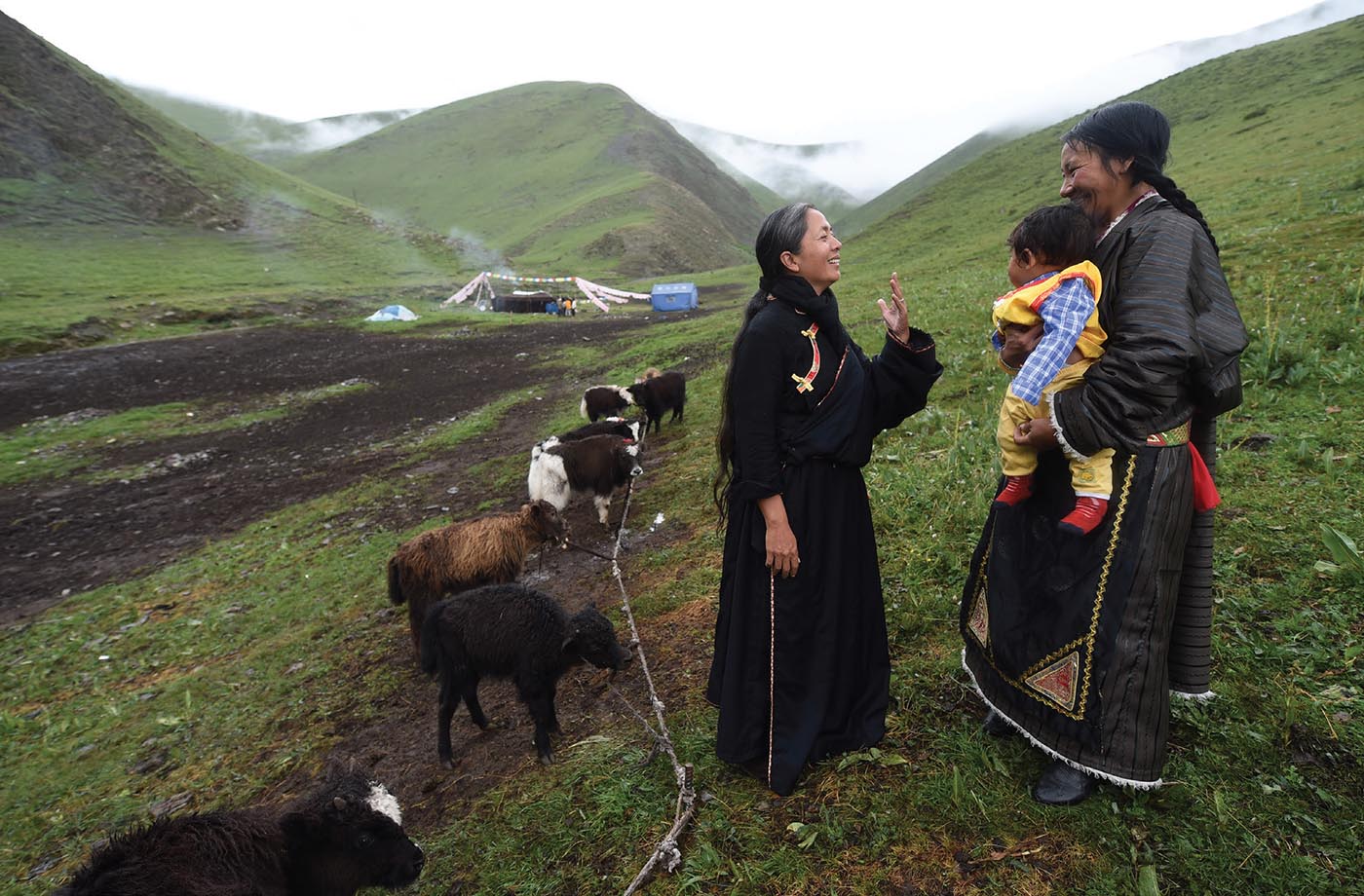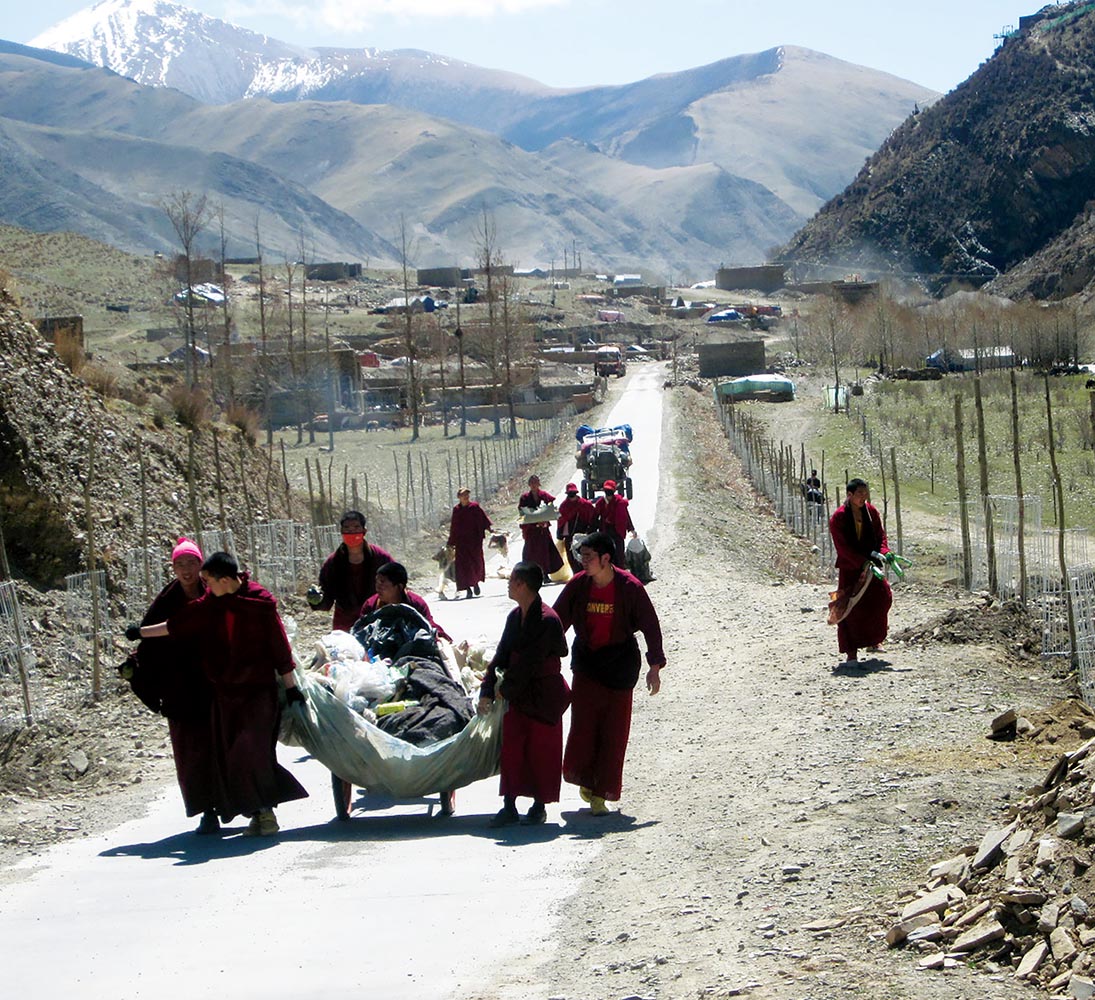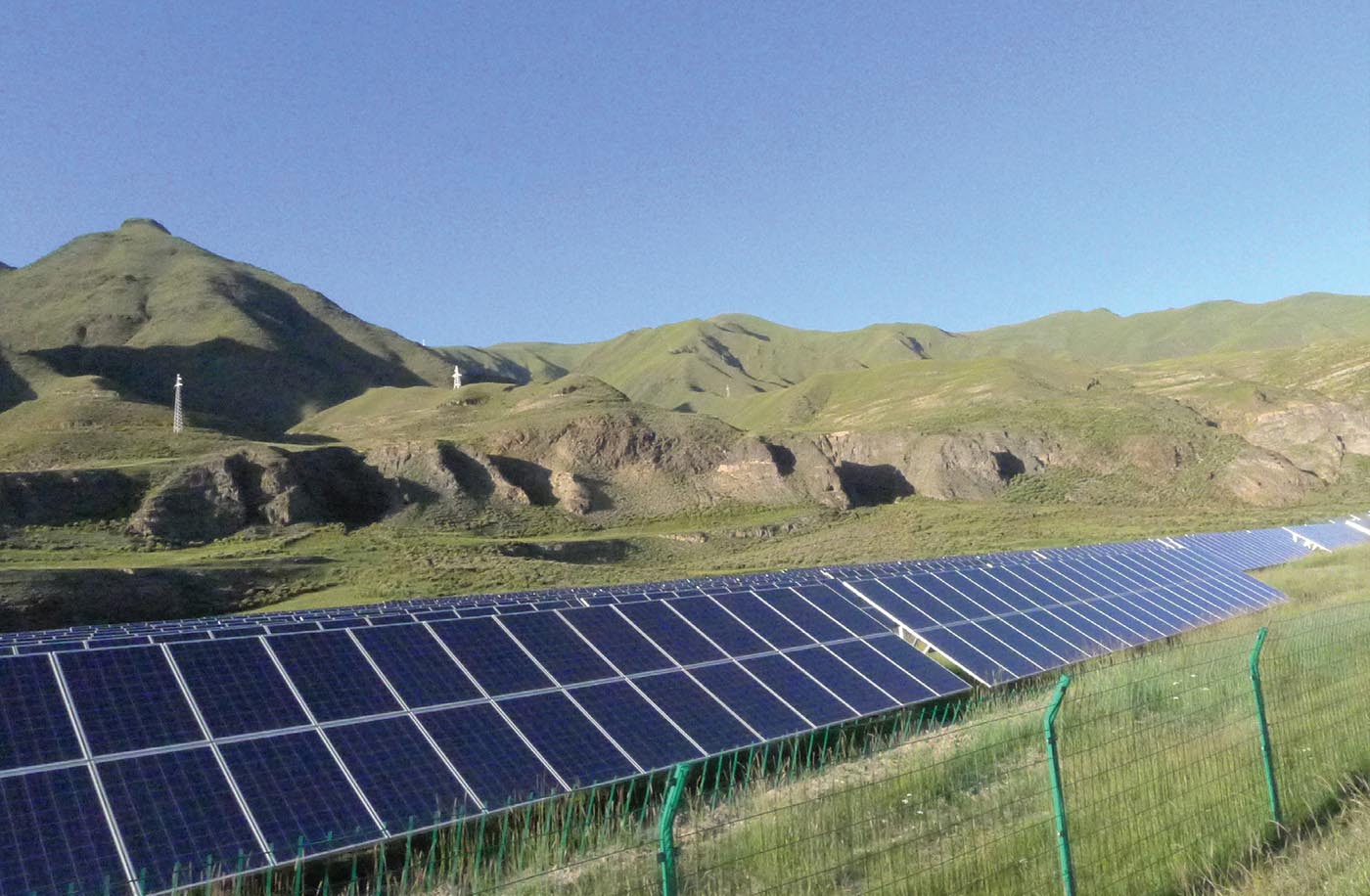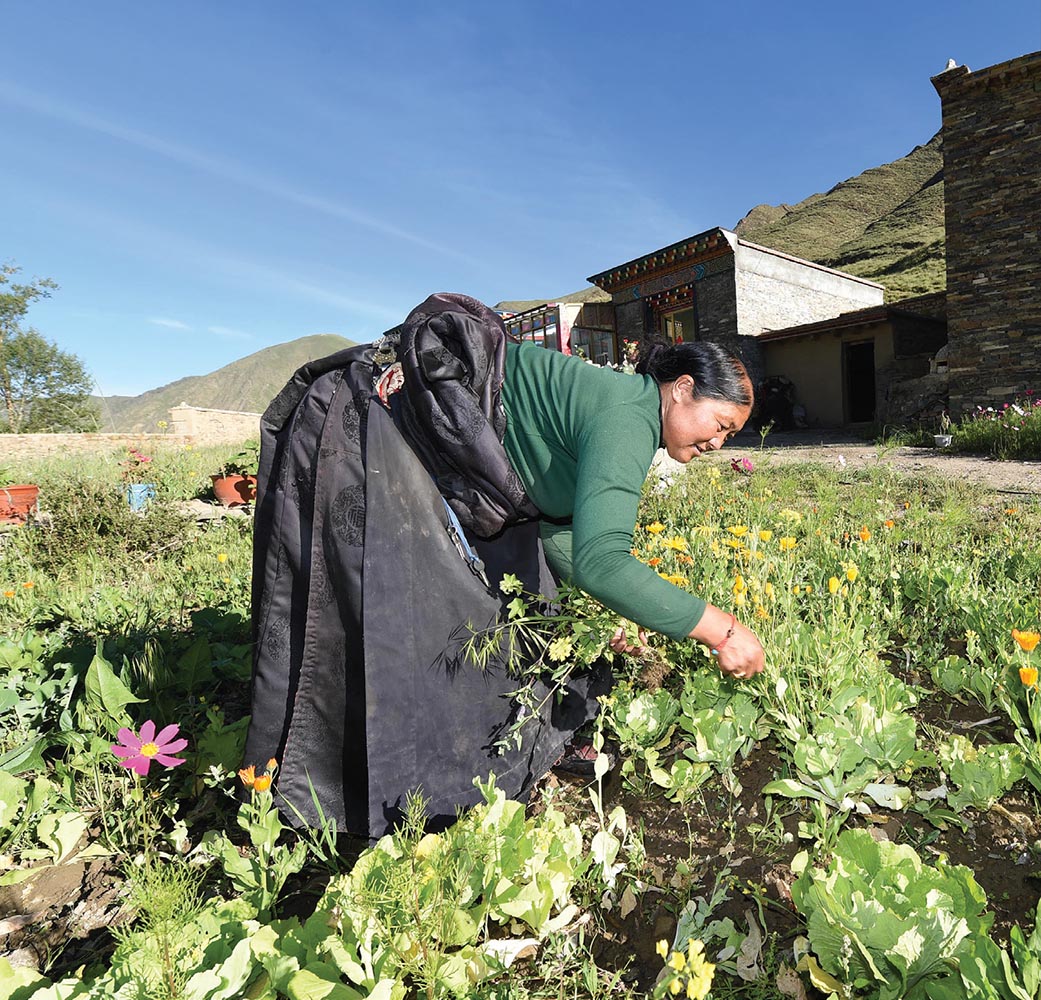Second Life at the Roof of the World
In 2010, I was invited to participate in an exhibition at the Museum of Contemporary Art (MoCA) in Shanghai, China. The exhibition of contemporary Indonesian artists was curated by Jim Supangkat (Indonesia) and Biljana Ciric (China), who selected my work Flag Project for the group exhibition. The work is a long-term, community-based artwork that I started in 2006. It started with a collaboration with Pondok Pesantren Amumarta in Yogyakarta, and I continued this work with other communities. For the group exhibition, I proposed to continue this project with other communities in China so that the public could understand the intention and concept behind a "community-based art project." At the time, such an artmaking method was not yet much practised in China.
The curators agreed with my proposal and assisted with looking for more information, as I wished to work with marginalised or disaster-affected communities. Biljana mentioned the recent earthquake in the Qinghai Plateau in Tibet; the earthquake occurred about two months before I arrived in China. The community still struggled in the aftermath of the earthquake. Although I had never been to the area, the situation reminded me of a similar experience working with earthquake-hit communities in Yogyakarta. After checking the affected area's condition, my assistant Li Mu agreed to accompany me there, so we eventually left Shanghai for Yushu Prefecture in the Kham area.
Foreigners and Tibetans from other areas were not allowed to enter without a permit because this area was considered politically and economically sensitive. Kham was the birthplace of five Dalai Lamas, and there was a long history of resistance. Moreover, scientists called this area "the future of China" due to its wealth of natural resources. Before leaving for Yushu, I was asked by the museum to sign some waiver statements in case I would get into trouble in the area!
To cut a long story short, I met with a group of monks from the Jiegu monastery in Yushu to gather information about the difficult post-earthquake recovery. I could see how people were still living in tents, and many buildings were in ruins. Chinese police and military were also still doing their recovery works. However, the Jiegu monastery head told me that I could get into serious trouble if the authorities discovered that I was a foreigner, so he advised me to go to another monastery in a remote area. That was the beginning of my introduction to and collaboration with the Lab gompa (“monastery”) and its community.

Fig. 1: Arahmaiani with nomad in Tibet, 2014. (Photo courtesy of Arahmaiani).
The logistics of this project were not easy, and I always needed a translator for communication. Moreover, scientific terms around environmental issues were not easy to explain, as there were no references from a local perspective. This was why I learned about Buddhism and the teaching of Tibetan Buddhism at the Sera Jey Monastery in India. This also allowed me to study the almost forgotten cultural heritage in Nusantara, the Indonesian archipelago. Many Indonesians have forgotten the close connections between Tibet and Indonesia during the Sriwijaya Kingdom (7th-12th century). During the 10th century, a Buddhist monastery in Muara Jambi (Sumatra) had a strong reputation among the Buddhist monastic community. The temple was considered a continuation of the Nalanda monastery tradition, the first Buddhist temple in India, so many monks from China and India would come to study there. One of them was Atisha Dipankara Srijnana (982-1054) from India, who came to study with the local master Dharmakirti. After he finished his studies, he went back to India to become a teacher. Atisha eventually made his way to Tibet and, to introduce the new teachings, founded the Kadampa school – the predecessor of the Gelugpa (Yellow Hat) school. Atisha's name is now famous as a leader for Mahayana Buddhism's reform in Tibet, where his teachings are still practised today.
I was fortunate to have the support of the head of the Lab monastery, Lama Kadheng Rinpoche. Eventually, I received permission from the local government to work there on the condition that I would not receive external funding, which meant that I had to pay for my trip and all the associated costs. Nonetheless, I felt that it was my calling, and I could not refuse it. Even though friends reminded me about the dangers that I would face, I stood firm in my wish to work and help there, even without any pay and facing serious risks. I realised that the situation would require innovative and creative approaches and problem-solving strategies that would not add to the existing problems.
This calling was also steered by another reason: the Tibet Plateau's importance for regional and global environmental sustainability. The Tibet Plateau is known as the "Asian water tower." This water source for more than 1.3 billion people who live on the Asian continent is threatened by droughts caused by global warming. This place is also known as "The Third Pole," or one of the most extensive ice surface areas on the planet, together with the North Pole and the South Pole. The ice and glaciers in this area are melting fast, causing regular floods and landslides that have claimed many victims in various Asian countries.

Fig. 2: Monks collecting garbage in Tibet. (Photo courtesy of Arahmaiani)
The environmental project began when I returned in the summer of 2011. For the first step, we implemented waste management because so much rubbish polluted the whole village. Even the rivers were full of waste, especially plastic! When I proposed managing the waste during my first visit in 2010, the suggestion was not taken up. Monks are at the top of the hierarchical system in the Tibetan community, so my suggestion was not easy for them to accept. Of course, I could understand their perspective, but I also had a strong reason to ask the monks to help because there was no support from the government for solving environmental issues. After the Lama had framed my arguments in line with their belief system, the monks finally agreed to be involved.
One of my assistants, a monk called Sonamrinchen, told me that, initially, the community was startled to see that the monks were collecting rubbish; they thought that the monks had gone crazy! However, after an arduous start, the first project ran smoothly, and the villages also joined in. Our following project was planting trees for preserving water. This time I did not face much opposition because a tree-planting project had already been initiated by the 13th Lab Kyabgon Rinpoche, in 1914. He predicted that tree planting was an action that would be needed in the future. He even built a mother tree temple for the first tree that he planted. Even before the project was approved and supported by the Chinese government in 2015, we had managed to plant more than 230,000 trees. In 2017, we received an award from an environmental organisation for our success in planting trees on "the roof of the world."
For the next project, I proposed the reintroduction of a nomadic lifestyle, a natural and traditional way of life, and a return to organic farming and barley planting. These changes were needed for ecological balance, safeguarding food security, and healthy living. I had seen that everyday food and drinking water were all processed items from China. The local community did not produce their food; even the water they consumed was bottled water, despite the area’s reputation as a place of water sources. I asked the monks to look for water springs around the Lab village, and I was astonished because they discovered more than 250 water springs!
Situated over 4000 metres above sea level, only a limited number of tree and plant species can grow in the area. Pine and poplar trees, planted in 1914, used to grow quite well. Nonetheless, when I started to work there, those trees were beginning to show signs of decay. So, we experimented with alternative planting techniques, and we managed to grow apple and walnut trees. We also developed winter protection techniques to have a greater variety of vegetables. Eventually, the activities in the Lab village attracted the attention of neighbouring villages who also wanted to be involved.

Fig. 3: Solar panel project, Kham Tibet. (Photo courtesy of Arahmaiani)
In 2015, when the government started to support the environmental project, 16 villages had joined. We also tried to revive elements of the nomadic lifestyle by starting a "Yak Bank." At the start of the project, the nomadic lifestyle was almost extinct because most young people did not want to live as nomads. They wanted to move to urban areas to get a “successful” life; the nomad lifestyle was considered out of date and non-profitable. This project was not easy to conduct because it required much money to supply the expensive yaks. Therefore, we started with a loan of 37 yaks for one nomad family, so they could start reviving the nomadic tradition and reconnect with the land.
Our last project was the most critical, namely water management. The water was to be used for daily activities and as an alternative energy source in the village. The Kham area is crossed by three large rivers: the Yangtze, the Mekong, and the Yellow River. With assistance from Chinese alternative energy and water management experts, this project is now running smoothly. As a result, villagers can consume healthy and clean local water for various needs. They also enjoy alternative energy that they produce independently, a method they were previously not aware of.
The focus points of this long-term project are education about nature, targeting the younger generation in the monastery and the outside villages, and women's empowerment. In addition, an alternative communal market is planned as a place where organic products or crafts can be sold among community members. One of the most important educational premises is a collaboration between the monastic community and the common people for handling everyday problems. This used to be outside the monastery tradition, in which worldly life was to be avoided by the monks.
The experiences and knowledge I gained while working with the Tibetan communities have given me insights into the connections between life and creativity. This connection is closely related to my learning about the culture and beliefs that developed in Indonesia a long time ago. While we can still see the biggest Buddhist temple in the world – namely the Borobudur temple in Central Java – as an example of the interrelation between Sriwijaya and Medang (Mataram) Kingdoms (8th-11th century), and the remains of the Buddhist temple in Muara Jambi, Sumatra, the majority of Indonesians are not aware of their history. I also recently became aware of the history of the Eloprogo area, an area of confluence between two rivers (Elo and Progo) near Borobodur, where Buddhist monks practised their meditation. It is believed Atisha also spent some time at this site. However, the culture and teachings related to these temples have mostly been forgotten.
This knowledge pushed me to research and explore what is left from the past culture and what is still practised in Indonesia, especially in Java and Bali. Even though the monastery traditions that I witnessed and experienced in Tibet are no longer practised, I could still find related localised culture and philosophy in Java and Bali. For example, I met with a small Tibetan Buddhism community, which started in Java about 30 years ago. It began with the arrival of a Tibetan Lama named Dagpo Rinpoche, who initiated Tibetan Buddhist teaching in Indonesia. In 2020, they opened a Gelugpa branch of Tibetan Buddhism in Batu, Malang (East Java). There are many interesting aspects of these past cultural practices, and they are connected to what is happening in Indonesia and the world today.

Fig. 4: Community member working in vegetable garden in Tibet (Photo courtesy of Arahmaiani).
The first aspect is the syncretic principle, as, in the past, Buddhism was deeply connected with Hinduism and Animism. Pluralism was supported by shared values from different beliefs in different cultures. Furthermore, there was an awareness and ability to appreciate differences as positive and enriching, as reflected in Indonesia’s national motto Bhinneka Tunggal Ika (“Unity in Diversity”). Given the current global condition where various cultures and belief systems are often enmeshed, I believe that such pluralist values are still highly relevant to be learnt and practised.
The second important point is the teaching of the Bodhisattva that stated, "may all beings be free from suffering." This teaching is based on compassion, the basic principle of Buddhism. Bodhisattva's teaching uses reason and logic to formulate the specific link between good intention, wisdom, and action as a basis for humility and considerate actions. It is also strengthened by another important principle, namely, a tradition of non-violence. In Indonesia today, many people are no longer interested in pursuing the principles above; they prefer materialist and individualist lifestyles. They perceive violence as a normal part of everyday life. This problem can be traced to many issues throughout Indonesian political history, especially to violent acts by those in power or those who want to control or gain profit from power. Violence and greed are rarely questioned, except by the people negatively affected, such as certain minority groups, women activists, or traditional communities.
Finally, another important historical reference relates to the position of women. A historical symbol of the highest knowledge and wisdom was prajnaparamita (“transcendental wisdom”), which was depicted through the figure of a meditating woman. It represents a balance between feminine and masculine energy or the interconnected balance of opposite fields in the universe. The principle of equality requires deep understanding, not a simplified black-and-white approach. Such understanding can become a positive force, urging people to understand the interconnections between nature, the elements, and the inhabitants. It can give people a greater understanding of the connections between the heart and the mind and about the principles of life. 1